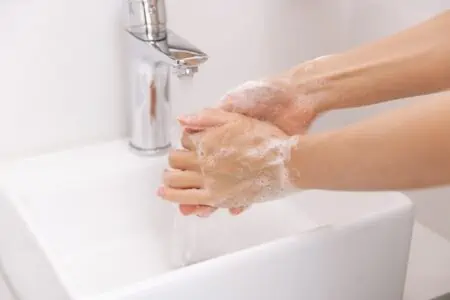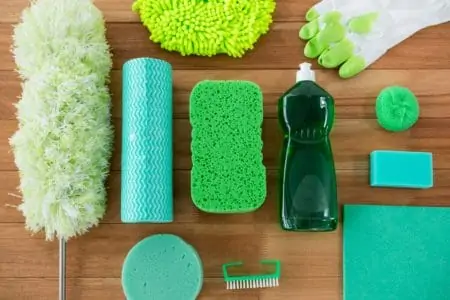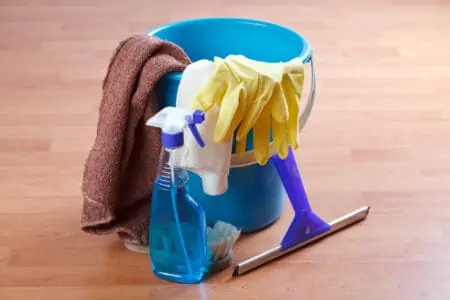Hand washing — what’s the big deal? Is it really that important? Maybe you’ve been lectured about the importance of washing your hands, but you’ve not really been educated on the facts and the statistics.
That’s where we come in. We’ll share 38 important and interesting hand washing statistics and facts. We’ll bust some myths, we’ll share some fun information, and we’ll also describe the benefits of hand washing. Overall, you might leave here shocked — before running straight to the bathroom sink to scrub your hands clean.
Let’s go.
Top 10 Hand Washing Statistics and Facts
- Hand washing can prevent the spread of various infections, such as respiratory illness.
- We touch our faces, on average, 23 times an hour. Regular hand washing prevents the spreading of illness from objects to ourselves.
- Only 58 percent of Americans always wash their hands after going to the bathroom at home.
- Bar soaps are not less hygienic than bottled soap.
- Using gloves isn’t more hygienic than not using them.
- Washing your hands for 20 seconds is the most effective.
- 2.3 billion people worldwide lacked hand washing facilities with soap and water as of 2020.
- The CDC found that healthcare workers only wash their hands half as often as they should.
- The CDC finds that healthcare providers might need to wash their hands up to 100 times per 12-hour shift.
- Most bacteria on your hands are lurking underneath your nails or on your fingertips.
Benefits of Hand Washing
You likely see hand washing signs in every public bathroom. What’s the real reason? Why scrub for the duration of the “happy birthday” song — twice? Here’s why hand washing is so crucial:
- Hand washing prevents illnesses: When you wash your hands with soap, you remove germs from your hands. This prevents the spread of diarrhea, respiratory infections, and other harmful diseases that can spread from object to object.
- What are the numbers: Hand washing can prevent diarrhea sickness by 40 percent. It can reduce respiratory illnesses by 21 percent. And finally, it can reduce absenteeism in schoolchildren by up to 57 percent.
- It protects children: Around the world, 1.8 million children under the age of five die from diarrheal diseases and pneumonia. Regular and proper hand washing could protect ⅓ of young children from diarrhea and almost 20 percent from respiratory illnesses.
- You remove dangerous germs: It’s easy to get dangerous germs on your hands. Feces can spread infections like Salmonella, norovirus, E. coli, hand-foot-mouth disease, adenovirus, and more. This likely happens after someone uses the toilet, changes a diaper, or even deals with raw meats. When you wash your hands after such activities, you prevent spreading these viruses to the next person.
- Germs pass through the face: On average, a person touches their face around 23 times an hour (1). Forty-four percent of these touches contact mucous membranes, which is how many illnesses are spread. You’re less likely to spread illnesses when you inevitably touch your face if you wash your hands regularly.
- Prevents illness in the workplace: You know when someone in your workplace comes in with a cold? Then one by one, do you all get it? Well, if everyone practiced regular hand washing, the cold wouldn’t spread as far and wide. This is also true for students living in close quarters.
- Minimize food-borne illnesses: If you cook from scratch often, you must practice regular hand washing to minimize the chance of getting horrible food-borne illnesses.
- It keeps kids healthy: Kids have less hefty immune systems than most adults. If you have kids in your home, practice regular hand washing to keep them safe and minimize them getting ill.
Hand Hygiene Facts and Myths
You might have heard some interesting facts about washing your hands over the years. We’re here to tell you whether it’s true or a myth.
- Not everybody uses hand soap: In America, only 58 percent of people always wash their hands with soap after going to the bathroom at home (2). One percent of people said they never do. Pretty gross!
- Antimicrobial soap: Many people reach for antimicrobial or antibacterial soap when they’re shopping. But did you know that it’s not necessary? Regular soap and water can remove germs just as well as antibacterial soap (3).
- Bar soaps: You might think that bar soaps are less hygienic, but the truth is — they’re not. If you would rather use a bar of soap to cut down on plastic waste, you won’t be any less hygienic than someone who uses a bottle of soap (4).
- You don’t need to use hot water: Cold water is completely fine for washing your hands. No need to scald your skin! It’s the act of surfactants in the soap that removes the germs, so it doesn’t matter what temperature you use.
- Hand sanitizer is the next best thing: When you can’t access soap and water, you should use hand sanitizer instead. Just remember that washing your hands with soap and water removes more germs and chemicals than hand sanitizer does (5). Hand sanitizer kills germs on contact, but soapy water removes them completely from your hands. If using hand sanitizer, ensure it has at least 60 percent alcohol to kill germs consistently.
- No need for gloves: You might think going out with gloves will protect you from more germs, but that’s not the case. A CDC study found that fewer people washed their hands when they wore gloves, which led to more bacteria, germs, and dirt (6). Unless you have sores or cuts on your hands, skip the gloves and practice more regular hand washing.
- The hand washing time matters: There’s a reason you’re taught to sing ‘happy birthday’ twice while washing your hands. Washing your hands for around 20 seconds is much more effective than washing them for five seconds.
- You must dry your hands: Fact. Wet hands spread germs more easily than dry hands spread germs (7). Dry your hands well after washing, using a paper towel, hand dryer, or normal towel.
- There are many reasons you should wash your hands: Going to the bathroom or handling food aren’t the only reasons you should wash your hands. Nope. You should wash your hands before eating, after you’ve sneezed, coughed, or blown your nose, administered first aid, touched pets or pet food, or taken out the trash. You should also wash your hands when you get home from a public place, before touching your face or doing makeup, or before and after putting on gloves.
- Hand-washing is a cheap prevention: Hand washing and hygiene is the most cost-effective way to reduce disease. Unfortunately, in 2020, 2.3 billion people worldwide lacked a hand washing facility with soap and water.
Hand Hygiene Statistics In Healthcare
Let’s get into hand washing compliance in healthcare workers. Here are some key facts:
- Healthcare workers don’t wash often enough: The CDC found that healthcare workers don’t wash their hands as often as they should (8). In fact, they clean their hands less than half as often as they should.
- Healthcare workers spread diseases: On a daily basis, about one in 31 hospital patients receive an infection from a healthcare worker.
- How to wash: Healthcare workers should use an alcohol-based hand rub or wash with hand soap and water before touching patients, performing aseptic tasks, working on a soiled body site, and immediately after removing gloves.
- Healthcare workers should wear gloves: They are the exception to glove wearing since they are often in contact with blood and other bodily fluids. They should wear gloves whenever they know they will contact blood, infection materials, and non-intact or contaminated skin. But healthcare workers must still follow hand hygiene protocol. Healthcare workers should change gloves when the gloves become damaged, soiled, or they are moving onto a new site or patient.
- Clean Hands Count (CHC) Campaign: The CHC campaign by the CDC is intended to encourage healthcare providers to follow more hand hygiene protocols (9). It reminds healthcare providers that they might need to clean their hands up to 100 times per 12-hour shift, depending on the circumstances.
- Hand hygiene has life-saving results: The WHO found that hand hygiene is seriously effective at reducing infections within healthcare settings (10). It’s also effective financially, saving 16 times the cost of implementing hand hygiene protocol.
- Hand hygiene facilities are lacking: 25 percent of health facilities worldwide don’t have basic water services. This results in 1.8 billion people without basic water services and 712 million without running water at all. Thirty-three percent of people lack hand hygiene facilities at their health care service. Only about nine percent of hand hygiene practices occur during the care of critically ill patients in low-income countries.
- Healthcare-associated illness is high: Globally, up to 15 percent of patients will suffer a healthcare-associated illness in acute care hospitals. It’s even higher in neonatal units; this can be up to 20 times more common, especially in low-income countries.
- Detrimental effect on maternal and neonatal deaths: 1 million of 4.1 million maternal and neonatal deaths yearly might be related to unhygienic practices, including lack of hand hygiene.
- There is hope: The compliance rate is increasing with more protocols and regulations. One study found an increase in the compliance rate from 47.5 to 81 percent, which was sustained for 11 months (11).
Fun Facts About Hand Washing
Want to learn a few more facts? You’ll wow people at your next trivia night with your new knowledge.
- Women are cleaner than men: Only 31 percent of men wash their hands after using a public bathroom versus 65 percent of women (12).
- We contact thousands of germs a day: If the fact that you contact 60,000 germs a day doesn’t make you want to wash your hands right now, we don’t know what will (13).
- Ninety-seven percent of people don’t wash their hands correctly: Only three percent of people from one study washed their hands correctly, with soap and water, for 20 seconds, then proceeded to dry their hands (14).
- Clean your nails: Most bacteria on our hands hide underneath our fingernails or on our fingertips (15). When you quickly wash your hands, you miss some of the most vital germs.
- Sing this instead: If you’re bored of singing ‘happy birthday’, you can also sing the chorus of ‘Sweet Caroline’, ‘Jolene’ or maybe ‘Love Shack’!
- Your kitchen towels are dirty: If you wash your hands and then dry them on your kitchen towel, you may need to wash them again. Your kitchen towel is full of bacteria. You should aim to swap it out with a new one every day or two.
- Wash your hands after turning the oven on: Those little knobs on your oven are bacteria bunkers. Think about how you often touch them after dealing with raw food. Aim to clean these every evening while wiping down your kitchen counters.
- Hand sanitizers won’t clean dirty hands: Hand sanitizers will kill bacteria, but they won’t remove dirt and soil from your hands. If you’re covered in mud or paint, you must clean your hands with soap and water.
- Fecal matter everywhere: There is fecal matter on more things than we like to admit. Studies found it on 10 percent of credit cards, 14 percent of bank notes, and 16 percent of mobile phones (16).
- Six seconds: Most people only wash their hands for six seconds. Six! Aim for 20.
FAQs
Hygiene, Health, and Hand Washing
To summarize, washing your hands is mega important. It can literally save lives.
You should wash your hands at least five times a day for 20 seconds using soap and water. Always wash your hands after using the bathroom and before and after preparing food or eating.
With these 38 eye-opening hand hygiene facts and statistics, you’re sure to scrub the skin more often using proper hand washing techniques.









